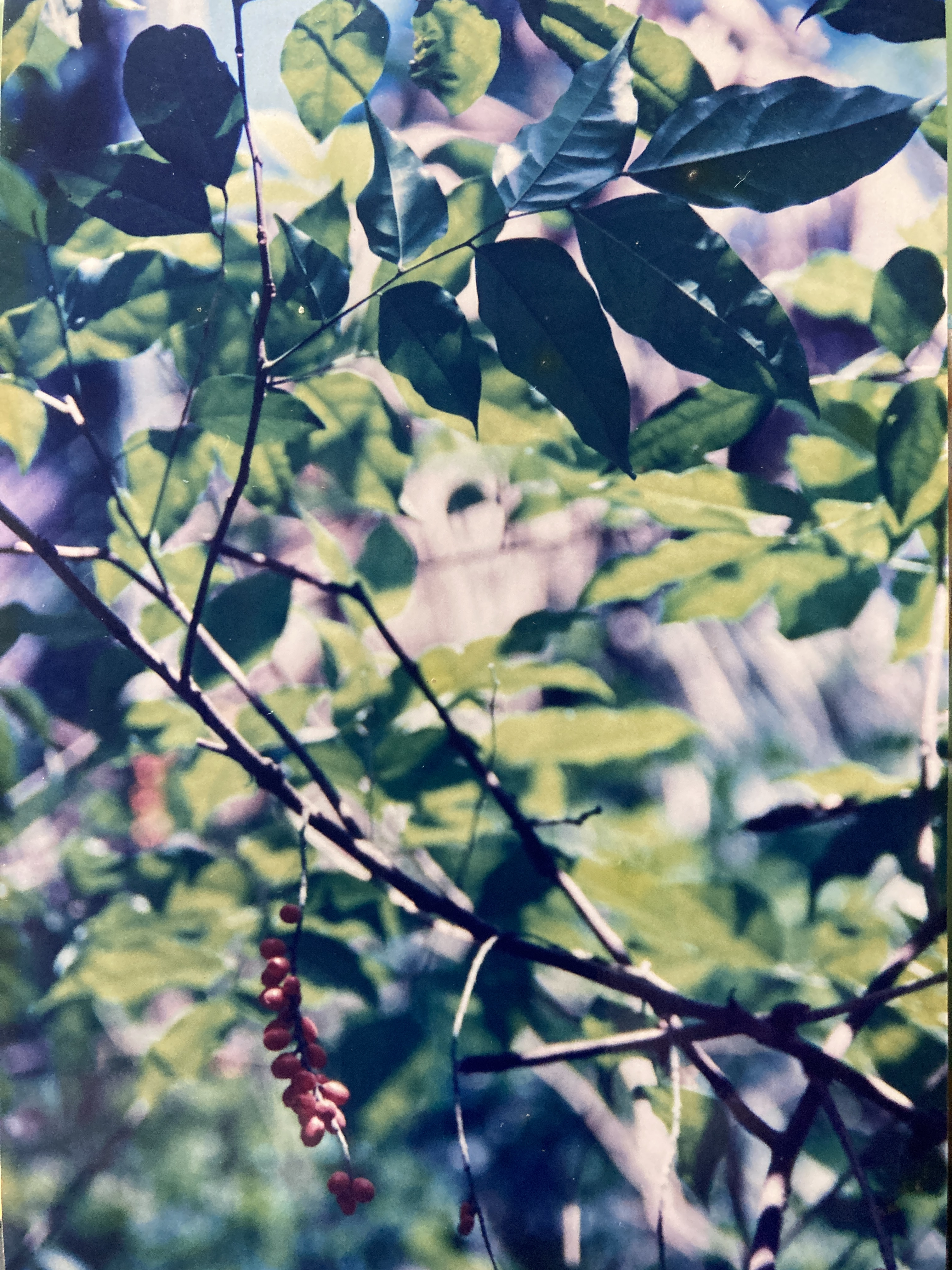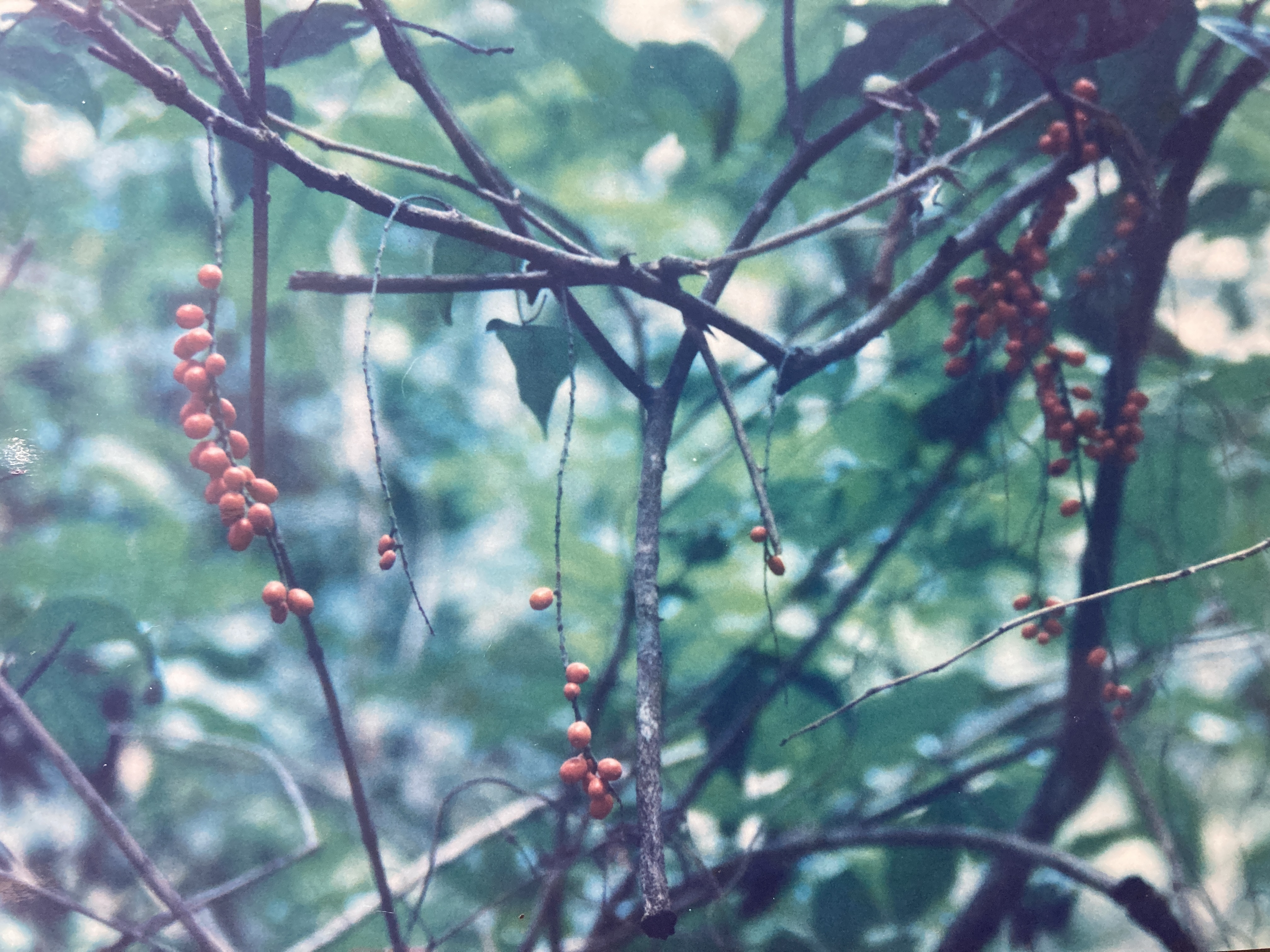Picramnia latifolia Tulasne
CORALILLO
Occasional evergreen understory treelet (3-10 m) encountered most frequently in the dark, moist lower layers of the primary forest. Of slight girth and small stature, this unobtrusive species usually remains undetected until it fruits, at which time long, hanging strings of startlingly orange berries adorn the Coralillo crown and cause it to stand out from the sullen hues of the surrounding forest understory.
Description: Coralillo is a small, open-canopied treelet with a straight trunk measuring no more than 10 cm in diameter. Its few branches are horizontal and restricted to the upper half of the bole where they produce a narrow crown. Picramnia bark is smooth, dark gray or olive in color, and very bitter to the taste (thanks to the presence of alkaloid chemicals). Among the most aesthetic and graceful of arboreal foliage, the leaves (42 cm by 24 cm) of this species are long, imparipinnately compound, and alternate. Picramnia leaflets (also alternately arranged) slowly grade in size and shape with distance along the petiole. The smallest and roundest blades (7 cm by 5 cm), located proximally, gradually yield to larger and more elliptical leaflets (18 cm by 7 cm) distally. Glossy, smooth, and entire, these attractive leaflets often have asymmetrical bases and very long (2 cm) drip tips. New leaf production occurs most abundantly during short bursts of growth that precede the multiple and successive intervals of fertility, between the months of October and January.
Flowers appear on long (20-25 cm), stringy racemes that emerge from both current leaf axils and old petiole scars – the latter located on the bare, inner portions of the branches. Petalless, each simple blossom is minute (2-3 mm) and composed of a five part green calyx; five prominent, red-anthered stamens; and a central pistil. When the anthers mature, they split longitudinally, revealing stores of contrasting, white pollen grains. Blossoming usually occurs as a series of two, or sometimes three, poorly synchronized events that begin as early as late October and last into February.
Fruits develop and ripen within about three months of flowering, and can be observed dangling from the same limp strands. Each plump, rounded berry (1 cm) ends in a tiny point. Bright orange in color and unusually (even aesthetically) arranged, these eye-catching fruit strings cause Coralillo to momentarily stand out from the surrounding multitude of shrubs and seedlings that share its dark habitat. Inside the fruit, a thin layer of flesh harbors a single, ovoid, red-colored seed. Occurring in discontinuous bursts over an extended period of time, the annual harvests take place from late January through May.
Similar Species: Among the small trees of the forest understory, there are no other species with such long leaves and characteristically shaped, glossy leaflets. Carboncillo (Swartzia panamensis) is a large tree whose leaflets do bear some resemblance to those of Coralillo, but they are arranged oppositely along the petiole.
Natural History: Coralillo flowers are pollinated by insects. Brightly colored, the anthers of these blossoms may be multi-functional, taking on the role more usually associated with showy flower petals and attracting potential pollinators with their dramatic hues. Coralillo fruits are eaten and dispersed by birds – Clay-colored Robins being especially fond of these small berries.
Uses: Holdridge and Poveda (1975) speculate that Coralillo might have some value as an ornamental species, given the attractive nature of its fruit strings. According to Morley (1978), the bitter bark and leaves of the Picramnia genus as a whole (consisting of about 50 tropical American species) may have medicinal value. He specifically mentions P. antidesma (also native to Costa Rica) as having liquorice-flavored bark and leaves that are used in rural medicine – in fact, they were once exported to Europe as a treatment for erysipelas and venereal disease.
Apparently, the bitter flavor associated with many plants can be attributed to the presence of a class of compounds known as alkaloids. Biologically very active, alkaloid chemicals often have a powerful effect on the human body and are responsible for many of the traditional remedies used by indigenous peoples to cure various ailments. They are also the source of many stimulants, hallucinogens, and pain killers now known to modern medicine. The variety of tropical rainforest plants that produce different types of alkaloids is staggering and represents an as yet largely untapped source of potentially lifesaving new medicines (Plotkin, 1993).
Distribution: In Manuel Antonio National Park (MANP), Coralillo is found at the feet of the towering giants of the primary forest, in the dark understory and usually in low-lying, moist sites. The species ranges from Costa Rica to Colombia.
Images: Leaf Flowers Fruits & Flower Buds Fruits




